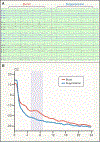Toward an interventional science of recovery after coma
- PMID: 38754372
- PMCID: PMC11827330
- DOI: 10.1016/j.neuron.2024.04.027
Toward an interventional science of recovery after coma
Abstract
Recovery of consciousness after coma remains one of the most challenging areas for accurate diagnosis and effective therapeutic engagement in the clinical neurosciences. Recovery depends on preservation of neuronal integrity and evolving changes in network function that re-establish environmental responsiveness. It typically occurs in defined steps: it begins with eye opening and unresponsiveness in a vegetative state, then limited recovery of responsiveness characterizes the minimally conscious state, and this is followed by recovery of reliable communication. This review considers several points for novel interventions, for example, in persons with cognitive motor dissociation in whom a hidden cognitive reserve is revealed. Circuit mechanisms underlying restoration of behavioral responsiveness and communication are discussed. An emerging theme is the possibility to rescue latent capacities in partially damaged human networks across time. These opportunities should be exploited for therapeutic engagement to achieve individualized solutions for restoration of communication and environmental interaction across varying levels of recovery.
Copyright © 2024 Elsevier Inc. All rights reserved.
Conflict of interest statement
Declaration of interests N.D.S. is a listed inventor on a patent application WO2023/043786 describing detailed methods of integrating magnetic resonance imaging, biophysical modeling, and electrophysiological methods for localization and placement of DBS electrodes in the CL/DTTm of the human thalamus as described in the paper cited in the review, Schiff et al.(21) N.D.S. is also a listed inventor on a related patent application WO2021/195062 and an issued US Patent 9,9592,383. All patents have been assigned by N.D.S. to Cornell University.
Figures







Similar articles
-
Finger or Light: Stimulation Sensitivity of Visual Startle in the Coma Recovery Scale-Revised for Disorders of Consciousness.Neurosci Bull. 2018 Aug;34(4):709-712. doi: 10.1007/s12264-018-0261-3. Epub 2018 Jul 18. Neurosci Bull. 2018. PMID: 30019217 Free PMC article. No abstract available.
-
A multicentre study of intentional behavioural responses measured using the Coma Recovery Scale-Revised in patients with minimally conscious state.Clin Rehabil. 2015 Aug;29(8):803-8. doi: 10.1177/0269215514556002. Epub 2014 Nov 7. Clin Rehabil. 2015. PMID: 25381347
-
Functional networks reemerge during recovery of consciousness after acute severe traumatic brain injury.Cortex. 2018 Sep;106:299-308. doi: 10.1016/j.cortex.2018.05.004. Epub 2018 May 12. Cortex. 2018. PMID: 29871771 Free PMC article.
-
Residual cognitive function in comatose, vegetative and minimally conscious states.Curr Opin Neurol. 2005 Dec;18(6):726-33. doi: 10.1097/01.wco.0000189874.92362.12. Curr Opin Neurol. 2005. PMID: 16280686 Review.
-
Spectrum of catastrophic brain injury: coma and related disorders of consciousness.J Crit Care. 2014 Aug;29(4):679-82. doi: 10.1016/j.jcrc.2014.04.014. Epub 2014 Apr 26. J Crit Care. 2014. PMID: 24930368 Review. No abstract available.
Cited by
-
The collapse of the wave function as the mediator of free will in prime neurons.Front Neurosci. 2025 Aug 21;19:1637217. doi: 10.3389/fnins.2025.1637217. eCollection 2025. Front Neurosci. 2025. PMID: 40918985 Free PMC article.
-
Advanced neuroimaging techniques to decipher brain connectivity networks in patients with disorder of consciousness: a narrative review.Neuroimage Clin. 2025 Aug 21;48:103864. doi: 10.1016/j.nicl.2025.103864. Online ahead of print. Neuroimage Clin. 2025. PMID: 40886590 Free PMC article.
-
A human brain network linked to restoration of consciousness after deep brain stimulation.medRxiv [Preprint]. 2024 Oct 18:2024.10.17.24314458. doi: 10.1101/2024.10.17.24314458. medRxiv. 2024. Update in: Nat Commun. 2025 Jul 21;16(1):6721. doi: 10.1038/s41467-025-61988-4. PMID: 39484242 Free PMC article. Updated. Preprint.
References
-
- Posner JB, Saper CB, Schiff ND & Claassen J. (2019) Plum and Posner’s diagnosis and treatment of stupor and coma. 5 edn, (Oxford University Press; ).
-
- Laureys S, Schiff ND. (2012) Coma and consciousness: paradigms (re)framed by neuroimaging. Neuroimage. 61, 478–91. - PubMed
-
- Laureys S, Celesia GG, Cohadon F, Lavrijsen J, León-Carrión J, Sannita WG, Sazbon L, Schmutzhard E, von Wild KR, Zeman A, Dolce G; European Task Force on Disorders of Consciousness. (2010) Unresponsive wakefulness syndrome: a new name for the vegetative state or apallic syndrome. BMC Med. 8, 68. - PMC - PubMed
-
- Giacino JT, Katz DI, Schiff ND, Whyte J, Ashman EJ, Ashwal S, Barbano R, Hammond FM, Laureys S, Ling GSF, Nakase-Richardson R, Seel RT, Yablon S, Getchius TSD, Gronseth GS, Armstrong MJ. (2018) Practice guideline update recommendations summary: Disorders of consciousness: Report of the Guideline Development, Dissemination, and Implementation Subcommittee of the American Academy of Neurology; the American Congress of Rehabilitation Medicine; and the National Institute on Disability, Independent Living, and Rehabilitation Research. Neurology 91, 450–460. - PMC - PubMed
-
- Giacino JT, Ashwal S, Childs N, Cranford R, Jennett B, Katz DI, Kelly JP, Rosenberg JH, Whyte J, Zafonte RD, Zasler ND. (2002) The minimally conscious state: definition and diagnostic criteria. Neurology. 58, 349–53. - PubMed
Publication types
MeSH terms
Grants and funding
LinkOut - more resources
Full Text Sources
Medical

